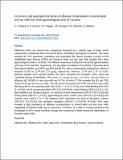| dc.description.abstract | Aflatoxins (AFs) are natural toxic compounds produced by a specific type of fungi, which subsequently contaminate foods and animal feeds, potentially carcinogenic to humans. This study assessed the AFs awareness, prevalence and associated risk factors through a survey of the smallholder dairy farmers (SDFs) and livestock feeds and raw cow milk samples from three agroecological zones in Tanzania. The aflatoxin awareness among SDFs (419) and agrovet dealers (26) was 23.2% and 50%, respectively. The prevalence of aflatoxin B1 (AFB1) in livestock feeds from agrovet dealers, and SDFs was 88.5 and 86.2%, with a concentration ranging from a limit of detection (LOD) to 22.99 and 32.9 μg/kg, respectively. However, 15.38 and 22.5% of AFB1 detected samples from agrovet dealers and SDFs exceeded the European Union (EU) and Tanzanian Bureau of Standards (TBS) limits of 5 μg/kg for dairy cow feeds. The prevalence of aflatoxin M1 (AFM1) in raw cow milk was 30.7%, of which 27.9% exceeded the EU and TBS limits of 0.05 μg/l for raw cow milk. The risk factors associated with AFB1 and AFM1 were cattle feeding systems: zero-grazing (odds ratio (OR) = 11.3 (1.5-22.9)) and mixed feeding (OR=16.0 (1.4-43.6)), use of concentrates feeds (OR=12.0 (0.6-55.6)), mixed feeding (OR=5.0 (0.5-11.1)); feed handling and storage practices: no moisture content measurement (OR=2.0 (0.3-15.0)) and storing feeds (OR=3.6 (1.7-8.5)); agroecological zones: central zone (OR=15.2 (5.4-50.6)) and northern zone (OR=2.1 (0.7-7.3)); aflatoxin (AF) awareness and level of education: primary (OR=16.0 (2.5-155.3)) and secondary education (OR=8.0 (2.14-43.9)) (P<0.05). This study revealed a high prevalence of aflatoxin contamination in animal feeds and raw cow milk, suggesting a potential health risk to consumers. Therefore, it is vital to increase awareness and knowledge on AFs, proper handling, storage and monitoring of feeds among the stakeholders in the dairy value chain. | en_US |

